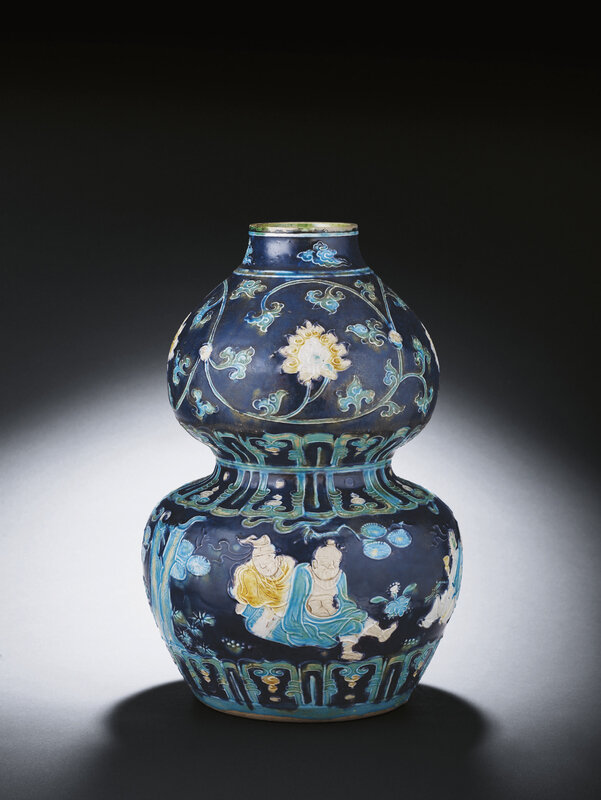An important and very rare Fahua double-gourd vase, Ming dynasty, late 15th-early 16th century
Lot 1864. An important and very rare Fahua double-gourd vase, Ming dynasty, late 15th-early 16th century; 5 7/16in. (13.6 cm.) high. Estimate: HKD 350,000 - HKD 450,000. Price realised HKD 487,500. © Christie's Image Ltd 2008.
The sturdily potted vase finely decorated to the lower bulb in an appliqué technique with 'The Eight Immortals of the Wine Cup', in pairs or on their own, holding wine cups or leaning on wine jars in a garden setting under pine trees and amidst flowers, between formal lotus lappet borders repeated on the lower section of the upper bulb decorated with a lotus scroll, the waisted neck with a border of trailing clouds, the moulded facial features of the Immortals reserved in the biscuit, the design within raised borders filled with translucent turquoise, white and ochre coloured glazes with copper-red patches to pick out details, all reserved on a ground of vibrant purplish-blue tone, Japanese wood box.
Provenance: The Egawa Art Museum, Japan.
Literature: Nihon Bijutsu no Nagare (1) - Yamatoe, Suibokuga, Kanga, Shoseki, Kogei, Japanese Art (1) - Yamato-e, Ink Painting, Chinese Painting, Calligraphy and Works of Art, The Egawa Museum, Hyogo Prefecture, Japan, 1993, p. 56, pl. 58
Note: This striking and rare fahua vase dates to the late 15th or early 16th centuries. The distinctive proportions of its form can also be seen in an unusual Hongzhi (1488-1506) underglaze-blue decorated vase, illustrated by Geng Baochang in Ming Qing ciqi jianding, Forbidden City Publishing, Beijing, 1993, p. 106, pl. 194. Interestingly, the current vase shares with the Hongzhi blue and white vessel a similar lotus scroll around the upper bulb, as well as similar petal bands around the lower part of both the upper and lower bulbs. However, the current fahua vase repeats the petal panel on the upper part of the lower bulb and has a figural design in place of the eight treasures on the blue and white vessel.
Fahua double-gourd vases are rare, and the somewhat more elongated example in the British Museum as been dated to the Jiajing reign (1522-66). The British Museum vessel, illustrated by J. Harrison-Hall in Ming Ceramics in the British Museum, BMP, 2001, p. 414, no. 13:10, has a design of Shoulao and the Eight Immortals arranged over both bulbs against a turquoise ground. While sharing with the current vase a petal band around the base, the British Museum vase has bands of emblems and clouds at the waist and another petal band around the mouth. The Eight Daoist Immortals also appear on a fahua lidded jar, in the collection of the British Museum, illustrated by J. Harrison-Hall, op. cit., pp. 418-9, no. 13:20. Similar to the current vase, the jar has a cobalt blue ground. Another jar decorated with the Eight Daoist Immortals, in the collection of the Idemitsu Museum, is illustrated in Chinese Ceramics in the Idemitsu Collection, Idemitsu Museum, Tokyo, 1987, no. 684; and the same museum has a garlic-headed vase bearing the Eight Immortals design around the body of the vessel. These vessels too have been dated to the Jiajing reign, during which Daoist motifs were particularly popular and the emperor was a fanatical follower of Daoist alchemy. Another fahua jar in the Capital Museum, Beijing, is decorated with a design of the Eight Immortals crossing the sea, illustrated by Liu Liang-yu in A Survey of Chinese Ceramics(4) Ming Official Wares, Aries Gemini Publishing Ltd., Taipei, 1991, p. 119, and has been dated to the Tianshun period (1457-64).
The current double-gourd vase is unusual not only in its shape, but in the fact that it has a rare and amusing depiction of the Eight Daoist Immortals known as 'The Eight Immortals of the Wine Cup'. In this version of the group the Immortals are shown seated on the ground - singly or in pairs - in various states of inebriation. Even in these informal poses, the Eight are shown with their attributes. Li Tieguai sits laughing with his iron crutch; Cao Guojiu and Zhang Guolao sprawl on the ground facing each other accompanied by their castanets and drum and drum sticks, respectively; Lan Caihe raises a wine cup and looks perilously close to falling over, but has a basket of flowers by his leg; He Xiangu and Lu Dongbin sit back to back holding each other up, oblivious of their respective attributes of lotus pod and sword; and lastly Zhongli Quan and Han Xiangzi lean sleepily on an large wine jar, which is presumably empty and lies on its side on the ground. This light-hearted subject became more popular later in the 16th century, and appears on a Wanli (1573-1620) wucai bowl in the Victoria and Albert Museum, illustrated by R. Scott and R. Kerr in Ceramic Evolution in the Middle Ming Period, Percival David Foundation, London, 1994, p. 19, no. 13; and also appears in textiles such as the 17th-century kesi illustrated by Feng Zhao in Treasures in Silk, ISAT/Costume Squad Ltd., Hong Kong, 1999, pl. 10.10a.
Christie's Hong Kong. Important Chinese Ceramics and Works of Art. 27 May 2008

/https%3A%2F%2Fprofilepics.canalblog.com%2Fprofilepics%2F1%2F0%2F100183.jpg)
/https%3A%2F%2Fstorage.canalblog.com%2F03%2F02%2F119589%2F96711876_o.jpg)
/https%3A%2F%2Fstorage.canalblog.com%2F11%2F31%2F119589%2F94773502_o.jpg)
/https%3A%2F%2Fstorage.canalblog.com%2F20%2F83%2F119589%2F94772815_o.jpg)
/https%3A%2F%2Fstorage.canalblog.com%2F26%2F72%2F119589%2F75604929_o.jpg)
/https%3A%2F%2Fstorage.canalblog.com%2F59%2F60%2F119589%2F26458628_o.jpg)



/image%2F1371349%2F20240319%2Fob_baa614_433894226-1635896913846988-54716078786.jpg)
/http%3A%2F%2Fstorage.canalblog.com%2F53%2F70%2F119589%2F128750806_o.jpg)
/http%3A%2F%2Fstorage.canalblog.com%2F87%2F77%2F119589%2F128750710_o.jpg)
/http%3A%2F%2Fstorage.canalblog.com%2F56%2F16%2F119589%2F128570993_o.jpg)